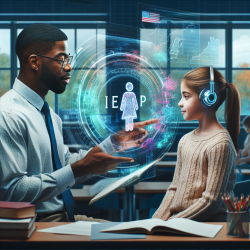Introduction
In the realm of speech-language pathology and child psychology, understanding the complex interplay of psychopathy traits, anxiety, and fear in children can significantly impact therapeutic approaches and outcomes. The research article "Skin Conductance Responses to a Discrete Threat in Virtual Reality: Associations with Psychopathy and Anxiety" offers valuable insights into this intricate relationship. By leveraging virtual reality (VR) technology, this study provides a novel perspective on assessing and understanding these traits in children, particularly those with conduct problems.
The Study at a Glance
The study involved 75 youths enrolled in non-mainstream schools, where a VR rollercoaster drop was used as a discrete fear-inducing event to examine skin conductance responses (SCR). The findings revealed that lower anxiety was associated with higher callousness, especially in youths with low SCR to discrete threats. This suggests a complex interaction between fear, anxiety, and distinct psychopathic traits such as narcissism, callousness, and impulsivity.
Implications for Practitioners
For practitioners working with children, particularly those with conduct problems, these findings underscore the importance of considering both physiological and emotional responses to fear-inducing stimuli. Here are some practical implications:
- Incorporate VR in Assessments: Using VR to simulate fear-inducing scenarios can provide a safe and controlled environment to observe children's physiological responses, offering deeper insights into their emotional and behavioral tendencies.
- Tailor Interventions: Understanding the nuanced relationship between anxiety, fear, and psychopathy traits can help tailor interventions that address specific emotional and behavioral needs, improving therapy outcomes.
- Monitor Physiological Responses: Regular monitoring of physiological responses, such as SCR, can aid in tracking progress and adjusting therapeutic strategies to better suit individual needs.
Encouraging Further Research
This study opens avenues for further research into the use of VR and physiological monitoring in understanding and treating psychopathy traits in children. Future studies could explore different VR scenarios and their impact on various psychopathy dimensions, as well as investigate the potential of VR as a therapeutic tool.
Conclusion
By integrating VR technology and physiological assessments into practice, speech-language pathologists and psychologists can enhance their understanding of psychopathy traits in children. This approach not only aids in more accurate assessments but also in developing targeted interventions that can lead to better outcomes for children with conduct problems.
To read the original research paper, please follow this link: Skin Conductance Responses to a Discrete Threat in Virtual Reality: Associations with Psychopathy and Anxiety.










